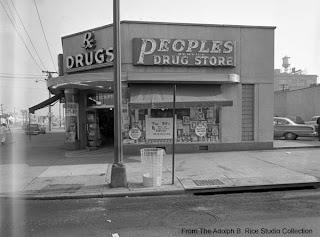When “A History of the Government of the City of Richmond” was published in 1899, the building we now know as Old City Hall had been completed only five years before. This otherwise relentlessly cheerful account of Richmond’s civil servants and the building they occupied noted only two dark days in the life of the young City Hall. One was when A. P. Shield (“a well-known citizen of Richmond”) pulled a pistol from his pocket and shot himself through the head in a room on the second floor. The other was the dramatic death on August 23, 1894 , of Colonel J. M. Winstead of Winston , North Carolina
[Read the newspaper account from the August 24, 1894
issue of the Richmond Times, from the Chronicling America site]
Richmond City Hall, pictured around the time of Winstead’s fall. The balcony he fell from is on the left hand side of the clock tower, above the roofline of the main building.
The Richmond newspapers reported passersby gathering at the northwest corner of the City Hall and speculating what caused Winsted’s 94-foot drop from the glassed-in observation area below the clock. One newspaper consulted a civil engineer, who stated quite positively that had Winsted jumped, he would have landed on the Broad Street sidewalk and not fallen straight down onto the fencing.
Willie Dunsford, who was standing on the corner of Tenth and Broad streets, happened to look up at the clock tower and provided the most exact description of Winstead’s end to a Richmond Dispatch reporter. Dunsford said he saw Winstead discard shoes, hat and cane, “then stand up on the railing of the balcony, bend over a little, and jump off headlong toward the ground.” No matter what caused it, witnesses to the aftermath who happened to be on Broad Street that day all agreed they would never forget “the disheartening sight” of Col. Winstead’s gory end on the cast iron fencing of City Hall.
Many people were drawn by a macabre compulsion to gain access to the “observation cupola” the next day. City Hall Superintendent Thompson closed the space to visitors, including one man firmly turned away by Janitor Lawrence Haake. “He did look like an insane person,” recalled Haake,” and “he walked away apparently much dissatisfied.” Stylishly dressed ladies, a visitor to Richmond staying next door at Ford’s Hotel, and the apparently insane were all treated alike and firmly turned away from the scene of the tragedy.
(click for larger view)
While the lurid debate raged in Richmond as to motives and causes for the incident, Winsted’s mangled remains were returned to North Carolina and his funeral was held the evening after the day of his fall. “An immense crowd of all classes” attended the service at Greensboro’s Green Hill cemetery. His friends at the funeral loyally maintained that Winstead’s hat blew off, and it was his attempt to catch his hat, not suicide, that caused his death.
The bent spear points of the decorative cast-iron fence below the clock tower on the Broad Street side still show evidence of Winstead’s fall.
The reason for Col. Winstead’s dramatic end, be it vertigo, self-destruction, leaning too far over the low balcony, or a chance gust of wind, will never be known. The intervening 116 years since Winstead made his way up to the City Hall clock tower has made this once sensational and very public death the tiniest of footnotes in Richmond’s long history. Nevertheless, the bent tines of the cast-iron railing where Winstead’s body was removed “with great difficulty” remain today as mute witness to a morning’s violence on Broad Street, and the dramatic end of the visitor from North Carolina.
- Selden


























